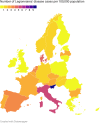Legionellosis risk-an overview of Legionella spp. habitats in Europe
- PMID: 36161570
- PMCID: PMC9511453
- DOI: 10.1007/s11356-022-22950-9
Legionellosis risk-an overview of Legionella spp. habitats in Europe
Abstract
An increase in the number of reports of legionellosis in the European Union and the European Economic Area have been recorded in recent years. The increase in cases is significant: from 6947 reports in 2015 to 11,298 in 2019. This is alarming as genus Legionella, which comprises a large group of bacteria inhabiting various aquatic systems, poses a serious threat to human health and life, since more than 20 species can cause legionellosis, with L. pneumophila being responsible for the majority of cases. The ability to colonize diverse ecosystems makes the eradication of these microorganisms difficult. A detailed understanding of the Legionella habitat may be helpful in the effective control of this pathogen. This paper provides an overview of Legionella environments in Europe: natural (lakes, groundwater, rivers, compost, soil) and anthropogenic (fountains, air humidifiers, water supply systems), and the role of Legionella spp. in nosocomial infections, which are potentially fatal for children, the elderly and immunocompromised patients.
Keywords: Aquatic pathogens; Disease control; Environmental microbiology; Legionella; Legionellosis.
© 2022. The Author(s).
Conflict of interest statement
The authors declare no competing interests.
Figures
Similar articles
-
Preventing legionellosis outbreaks by a quick detection of airborne Legionella pneumophila.Environ Res. 2019 Apr;171:546-549. doi: 10.1016/j.envres.2019.01.032. Epub 2019 Jan 15. Environ Res. 2019. PMID: 30763875
-
Combining Environmental Investigation and a Dual-Analytical Strategy to Isolate the Legionella longbeachae Strain Linked to Two Occupational Cases of Legionellosis.Ann Work Expo Health. 2018 Mar 12;62(3):321-327. doi: 10.1093/annweh/wxx109. Ann Work Expo Health. 2018. PMID: 29304227
-
[Legionella infection--a neglected problem].Epidemiol Mikrobiol Imunol. 2014 Feb;63(1):43-9. Epidemiol Mikrobiol Imunol. 2014. PMID: 24730993 Czech.
-
Legionella spp.: community acquired and nosocomial infections.Curr Opin Infect Dis. 2003 Apr;16(2):145-51. doi: 10.1097/00001432-200304000-00011. Curr Opin Infect Dis. 2003. PMID: 12734447 Review.
-
Surveillance of hospital water and primary prevention of nosocomial legionellosis: what is the evidence?J Hosp Infect. 2005 Apr;59(4):273-9. doi: 10.1016/j.jhin.2004.09.031. J Hosp Infect. 2005. PMID: 15749313 Review.
Cited by
-
Clinical and Environmental Surveillance for the Prevention of Legionellosis.Microorganisms. 2024 May 6;12(5):939. doi: 10.3390/microorganisms12050939. Microorganisms. 2024. PMID: 38792769 Free PMC article.
-
Legionella pneumophila subverts the antioxidant defenses of its amoeba host Acanthamoeba castellanii.Curr Res Microb Sci. 2025 Jan 7;8:100338. doi: 10.1016/j.crmicr.2024.100338. eCollection 2025. Curr Res Microb Sci. 2025. PMID: 39877885 Free PMC article.
-
An outbreak of Legionnaires' disease linked to a municipal and industrial wastewater treatment plant, The Netherlands, September-October 2022.Euro Surveill. 2024 May;29(20):2300506. doi: 10.2807/1560-7917.ES.2024.29.20.2300506. Euro Surveill. 2024. PMID: 38757288 Free PMC article.
-
Legionella pneumophila modulates macrophage functions through epigenetic reprogramming via the C-type lectin receptor Mincle.iScience. 2024 Aug 8;27(9):110700. doi: 10.1016/j.isci.2024.110700. eCollection 2024 Sep 20. iScience. 2024. PMID: 39252966 Free PMC article.
-
A Pilot Study for Legionella pneumophila Volatilome Characterization Using a Gas Sensor Array and GC/MS Techniques.Sensors (Basel). 2023 Jan 26;23(3):1401. doi: 10.3390/s23031401. Sensors (Basel). 2023. PMID: 36772440 Free PMC article.
References
-
- Alexandropoulou IG, Ntougias S, Konstantinidis TG, et al. Environmental surveillance and molecular epidemiology of waterborne pathogen Legionella pneumophila in health-care facilities of Northeastern Greece: a 4-year survey. Environ Sci Pollut Res. 2015;22:7628–7640. doi: 10.1007/s11356-014-3740-8. - DOI - PubMed
-
- Almeida DQ, Silva T, Rodrigues V et al (2021) Outbreak of legionnaires’ disease in the Northern Portuguese Coast During the COVID-19 Pandemic. Acta Medica Port 10.20344/amp.15823 - PubMed
Publication types
MeSH terms
Substances
LinkOut - more resources
Full Text Sources
Miscellaneous



